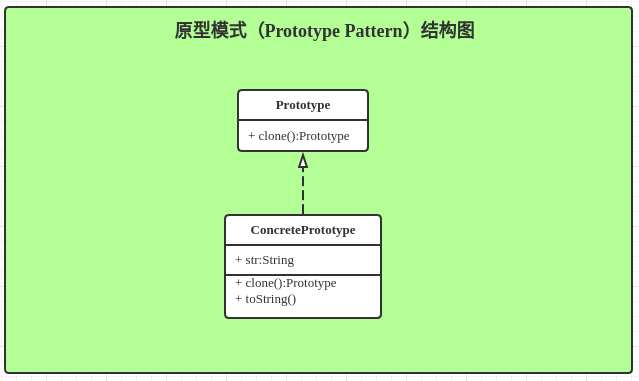设计模式之原型模式
原型模式
-
原型模式结构图:

-
示例代码:
// 具体对象A,浅克隆 @Data public class ConcretePrototypeA implements Cloneable{ private String str; private List<String> list = new ArrayList<>(); public ConcretePrototypeA(String str) { this.str = str; } public ConcretePrototypeA clone(){ ConcretePrototypeA cloneType = null; try { cloneType = (ConcretePrototypeA) super.clone(); } catch (CloneNotSupportedException e) { e.printStackTrace(); } return cloneType; } } // 具体对象B,深克隆 @Data public class ConcretePrototypeB implements Serializable{ private String str; private List<String> list = new ArrayList<>(); public ConcretePrototypeB(String str) { this.str = str; } public ConcretePrototypeB clone(){ try { ByteArrayOutputStream outputStream = new ByteArrayOutputStream(); ObjectOutputStream ops = new ObjectOutputStream(outputStream); ops.writeObject(this); ByteArrayInputStream inputStream = new ByteArrayInputStream(outputStream.toByteArray()); ObjectInputStream ois = new ObjectInputStream(inputStream); return (ConcretePrototypeB)ois.readObject(); } catch (Exception e) { e.printStackTrace(); } return null; } } // 测试 public class PrototypeTest { public static void main(String[] args) { // 浅克隆测试 ConcretePrototypeA prototype = new ConcretePrototypeA("测试原型"); ConcretePrototypeA clone = prototype.clone(); System.out.println(prototype); System.out.println(clone); clone.setStr("克隆原型"); System.out.println("==================="); System.out.println(prototype); System.out.println(clone); System.out.println("======================"); prototype.getList().add("原型字符串"); clone.getList().add("克隆字符串"); System.out.println(prototype); System.out.println(clone); System.out.println("++++++++++++++++++++++++++++++++++++"); // 深克隆测试 // 浅克隆测试 ConcretePrototypeB prototypeB = new ConcretePrototypeB("测试原型B"); ConcretePrototypeB cloneB = prototypeB.clone(); clone.setStr("克隆原型B"); System.out.println("==================="); prototypeB.getList().add("原型字符串B"); cloneB.getList().add("克隆字符串B"); System.out.println(prototypeB); System.out.println(cloneB); } } -
总结:原型模式在java中自带的是浅克隆,只需要实现Cloneable接口并重写Object.clone()方法即可,调用super.clone()方法,会直接在堆内存中以二进制流的方式进行复制,因此效率很高,但是如果类中存在引用对象属性,则原型对象和克隆对象的该属性会指向同一对象的引用.Java中深克隆通常使用序列化的方式.
优点:Java自带的原型模式基于内存的二进制流的复制,在性能上比直接new一个对象更加优良;
缺点:需要为每一个对象配置一个clone方法,clone方法在类的内部,当对已有类进行改造时,违背了开闭原则.





【推荐】国内首个AI IDE,深度理解中文开发场景,立即下载体验Trae
【推荐】编程新体验,更懂你的AI,立即体验豆包MarsCode编程助手
【推荐】抖音旗下AI助手豆包,你的智能百科全书,全免费不限次数
【推荐】轻量又高性能的 SSH 工具 IShell:AI 加持,快人一步
· 从 HTTP 原因短语缺失研究 HTTP/2 和 HTTP/3 的设计差异
· AI与.NET技术实操系列:向量存储与相似性搜索在 .NET 中的实现
· 基于Microsoft.Extensions.AI核心库实现RAG应用
· Linux系列:如何用heaptrack跟踪.NET程序的非托管内存泄露
· 开发者必知的日志记录最佳实践
· winform 绘制太阳,地球,月球 运作规律
· TypeScript + Deepseek 打造卜卦网站:技术与玄学的结合
· AI 智能体引爆开源社区「GitHub 热点速览」
· 写一个简单的SQL生成工具
· Manus的开源复刻OpenManus初探